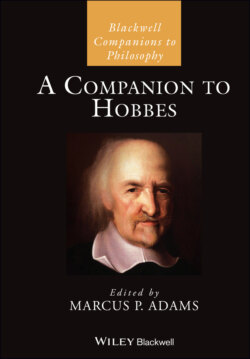Читать книгу A Companion to Hobbes - Группа авторов - Страница 41
Notes
Оглавление1 1 See also Leviathan XVI (2012, 244; 1651, 155), Leviathan XXIV (2012, 388; 1651, 190).
2 2 Thomas Stanley’s influential History of Philosophy, devoted many chapters to Stoicism, including chapters on the corporeal God, the void and time (see Stanley 1655–1660, Vol. II, Part 8, 115–19, 123–4).
3 3 De anima v (1885, 185): “The soul certainly sympathizes with the body, and shares in its pain, whenever it is injured by bruises, and wounds, and sores: the body, too, suffers with the soul, and is united with it (whenever it is afflicted with anxiety, distress, or love).” See also De anima vii (1885, 187).
4 4 As with finite souls, Tertullian emphasizes the Stoic objection to dualism that an incorporeal substance cannot act on body. See Evans (1948, 234–7) for discussion of the Stoic background to these texts. On Hobbes’s appeal to these texts in support of materialism, see Riverso (1991, 92).
5 5 For example, in the tract against yet another heretic, Hermogenes, Tertullian invokes with sympathy the Stoic model of God’s mixture with matter: “The Stoics maintained that God pervaded matter, just as honey the honeycomb” (Ad Hermogenes xliv; 1885, 501). Hobbes hints at a closer reading of Tertullian in the Answer to Bramhall, mentioning that De carne Christi is “now extant among his other works” (EW IV.307).
6 6 See Saunders (1955). While in exile, the Cavendishes occupied the former residence of Peter Paul Rubens, who was sympathetic to Stoicism and whose brother, Philip, was a follower of Lipsius. See O’Neill’s Introduction to Cavendish (2001, xiv). On the Rubens’ involvement in the Neo-Stoic circle at Antwerp, see Morford (1991).
7 7 “Discourse of Liberty and Necessity”, section xviii (Bramhall 1842–1844, IV, 116). See also “Defence of True Liberty” (Bramhall 1842–1844, IV, 119). In his Introduction to the defence or “vindication,” Bramhall labels Hobbes’s position “sublimated stoicism” (EW IV.20).
8 8 It is not surprising that the vitalist Cavendish objected to Hobbes’s principle in Leviathan II that “when a thing lies still, unless somewhat else stirs it, will lie still forever” (2012, 26; 1651, 13. cf. De corpore; EW I.115; OL I.102) because it seems to make self-motion impossible (Cavendish 1664, 21). Hobbes’s corporeal God doctrine was not yet formulated.
9 9 On Cavendish’s concerns viz. the foundations of natural philosophy, see Clucas (1994), James (1999), Detlefson (2006), and Sarasohn (2010).
10 10 “In any part of space in which motion is made three times may be considered: past, present and future” (OL I.176; EW 204; see also OL I.98; EW I.110–11).
11 11 For an illuminating discussion of Hobbes’s presentism, which emphasizes different issues than the present discussion, see Medina (1997).
12 12 See also De corpore XV (OL I.176; EW I.204).
13 13 See also De corpore XXV (OL I.318; EW I.391). Memory allows animate beings to compare fleeting successive sensations: “sense … has necessarily some memory adhering to it, by which former and later phantasms may be compared together and distinguished from one another” (OL I.321; EW I.393).
14 14 For more on the reality of Hobbesian time, see Gorham (2014b).
15 15 For a detailed, recent discussion of the Stoic incorporeals, especially void and time, see Tzamalikos (1991).
16 16 Leijenhorst (2002, ch.3); Slowik (2014).
17 17 Though see Brandt (1917), Spragens (1973), and Leijenhorst (1996).
18 18 Leijenhorst (1996, 430) notes some Aristotelian features of Hobbes’ conception of causality in early works like the Short Tract, but acknowledges that in his mature natural philosophy Hobbes affects a “radical breach” with Aristotle.
19 19 “Affirmat quidem Deus esse Corpus” (2012, 1228; OL III.561).
20 20 Hobbes seems to embrace corporeal God in at least two other places: An Historical Narration Concerning Heresy (EW IV.398) and Considerations Upon the Reputation, Loyalty, Manners and Religion of Thomas Hobbes (EW IV.427). Also in the much earlier (1641) letter to Mersenne, Descartes dismisses Hobbes’s mention (in a lost letter to Descartes) of “the corporeal soul and God” (anima & Deo corporeis) (AT 3.287).
21 21 Curley (1992), Jesseph (2002), and Martinich (1992).
22 22 Fortunately, a number of authors have very recently presented detailed discussions of the corporeal God doctrine; but they do not investigate in much detail its likely sources. See Lupoli (1999), Leijenhorst (2004), Weber (2009), and Springborg (2012).
23 23 See also Alexander of Aphrodisias’ similar complaint against the Stoics for “claiming the existence of two universal principles, matter and God,” which are mixed yet unequal (On Mixture XI, 224–5, T 1976, 139; LS 1987, 273, 275).
24 24 See also Diogenes Laertius, Lives of the Philosophers 7, 150; 1997, 137; Sextus Empiricus, Against the Professors 9, 75–6, LS 1987, 269; Plutarch, On Stoic Self-Contradictions, 1053f; LS 1987, 284.
25 25 See also Leviathan XXXIV (2012, 612; 1651, 303). The editor of this volume has rightly observed that in passages of Leviathan in which Hobbes equates spirit and breath or pneuma, he is mainly dealing with the Christian (not necessarily Stoic) sources of this doctrine. Hobbes’s appeal to the doctrine in the Answer to Bramhall, however, is revealing since it comes just before his detailed defense of the corporeal god. So it is ironic that the Cambridge Platonist Ralph Cudworth, in his vehemently anti-Hobbesian tome, The True Intellectual System of the Universe (1678), diagnoses atheists as suffering from “pneumatophobia”: “an irrational but desperate abhorrence from spirits or incorporeal substances” (1845, Vol. I, 200).
26 26 For discussion see Sambursky (2014, ch. 3), Todd (1978), and especially Sorabji (1988, chs. 5–7).
27 27 For further discussion of the parallels between the Stoic and Hobbesian physico-theologies, see Gorham (2014a). See Gorham (2013) for more on the role of corporeal God in Hobbesian physics.
